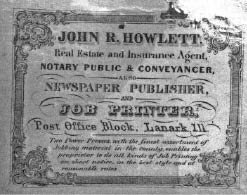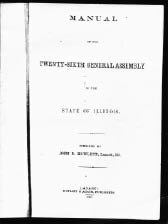
Discover rewarding casino experiences. 

Please Don't Quote Me PART II — CARROLL COUNTY GAZETTE |
“TEN YEARS AGO we came to Lanark an entire stranger for the purpose of establishing a newspaper. This was a new idea to most of its inhabitants. It was thought to be a chimerical enterprise in so small a town and so recent in birth...,” wrote the editor John R. Howlett, in part, in Lanark’s only newspaper by that date. You will note the date and that ten years before would mean he’d come in 1864, not 1863 as some sources state. Other arguments were presented last week including his filed records at the state level. Herewith follows a news item from the “Lanark Banner’s” or “Carroll County Banner,” first issue in 1864. He’d discovered it in a scrapbook, the only item from Lanark’s first newspaper, all other issues having burned in a fire in 1872. 1864—”After many unavoidable and vexatious delays we at last present our readers with the first number of our paper. The first presentation of a paper is an uncertain experience; perhaps more uncertain in a town not yet three years old; crops were harvested in the very ground it now stands. But we have the same faith in the enterprise displayed in rapidly building up a town as in building up the paper. We came among you a stranger making no profession of ability, only desiring of giving you a good readable family newspaper...” That column of the 1864 “Banner” went on for several more paragraphs followed by Howlett’s current remarks (1874) saying he had the same wishes and to quote, “It would be singular if in these ten years we had not on occasion offended some of our patrons. Any editor who is honest in his convictions and outspoken in his sentiments cannot fail to tread on someone’s toes. We cannot all think alike but while firmly maintaining our opinions, we cheerfully accord to all others the same right we claim for ourselves and no one can say knowingly we do not.” John Howlett’s reminiscence may have been an intuition of days to come, those past having their share of problems. For some time his health had been giving him a melancholy attitude ... “The editor is still under the weather. We are through prophesying when we will be back at the office.” Exchanges from other newspapers commented on the feisty editor’s condition, blaming it mostly on the work load he had committed himself to the recent years.
He had worked tirelessly for three years at the “Lanark Banner” he’d initiated, the print shop located on lower Broad, east side, as reference gives (last week). And then for some unknown reason, perhaps, a new challenge, he sold it to J.E. Millard whose first edition came out September 4, 1867 and with “only fair support” continued until January of 1871. He sold the equipment and fixtures to some in Davis which sold it subsequently to Pecatonica. “Davis Weekly Gazette was begun in 1872 by W.A. Colby and N.L. Colby who operated it for about a year. They being from Pecatonica, apparently took some of the equipment back there while the business was sold to the Stabeck’s who operated it until 1878. Subsequent changes were several. Meanwhile, or rather previously, Howlett had moved to Shannon where in 1868 he changed the “Shannon Gazette’s” name to “Carroll County Gazette” and launched a competitor to Millard’s rendition of the “Banner.” During this time Howlett was issuing several other papers: Thomson Courier, Rock City Gazette, Winnebago County Advertiser (Durand), Shannon and Carroll County Gazette, and an advertising sheet for Savanna. Because he was so ambitious one might wonder if he was responsible for the huge canvas-like map we mention last week ... Carroll County with illustrations of several notable structures; residence and commercial. It’s a solution to search for. Maybe the Gazette assembled the material and it was printed elsewhere as it would be unlikely that suitable equipment would be in such a small town’s shop. They could, however, have set up and printed a book, sending it out only to be bound. A friend some years ago gave us a book whose frontispiece piece is printed here, reduced. An ambitious undertaking in so small a town and in 1869. It is a hard cover, bound book and it lists “Howlett and Adair, publishers. Lanark, Illinois.” “Job work” was the life blood for many a print shop, paying the bills because less time was spent selling ads, setting rates or making up the type, whatever ... Stationery, receipts, business and calling cards, letterheads, church and school pamphlets, etc. Were Howlett and Adair exploring the market of book publishing? The Howlett and Adair partnership had formed just after the Civil War. Too, James Newcomer joined the staff, working there for four years, then moving on to Lena where he became editor of the “Star.” Printers were notorious for moving. And as for “chimerical” attitude, as he had mentioned, Howlett opened an office again in Lanark, meanwhile keeping the Shannon plant going. For what reason did he open a shop where the “Banner” was already doing business? Was it more the center of the county? Better to keep in touch with courthouse news, circulation? The thing was Millard had had Howlett sign an agreement not to publish a paper in Lanark within a year of the date of sale. But here he was only months into that year. Millard ordered an injunction against Howlett to prevent future publishing. What does he do? He sold the newspaper to John Adair. And were the two papers directly across the street from one another? Source gives that two of the offices occupied by Howlett were in mid-block on lower Broad, pictured last week, and on the southwest corner of Broad and West Locust. No definite time line is available and this is a guess using “ancient” source. The two rivals would have been almost directly across Broad Street, if so. That procedure to prevent publishing in opposition was not uncommon. Perhaps the method Howlett used, “selling” to a friend for temporary occupation, was also. At the end of the year’s ban, Howlett took “ownership” again so in 1868 the town had two direct rivals in the newspaper game. This continued until 1871, about three years, when Millard had a chance to sell equipment and fixtures to someone in Davis who subsequently sold to the Pecatonica News as before written. Millard was leaving the printing business because he’d been elected County Superintendent of Schools, a good opportunity to quit the sometimes anxiety-ridden business of printing. Many changes were on the agenda in the days, years to come for Howlett. Perhaps to one-up Millard back in 1870, Howlett had, apparently, moved to the new, prestigious, “Post Office Block,” northeast corner of Broad and East Locust (see last week). An ad said, “Job printing at Chicago prices. Call at Post Office Block, 2nd story.” January, 1871, Howlett remarks, “In parting with Mr. Adair we have been associated for four years in household and as an editor—never have had a word of difficulty—our kindest wishes for his prosperity and success.” As late as October, 1870 Adair was listed on the Carroll County Gazette as publisher. Then in April, 1871, the Gazette announced that he had assumed editor of the Mt. Carroll Mirror. Some major upset must have occurred with the Gazette though because in the ensuing next few months, several comments in the Gazette allude to something dire having oπ, among them a panicked-sounding plea in July of 1871, “I need to raise $5,000.00...” —NEXT WEEK!
|




